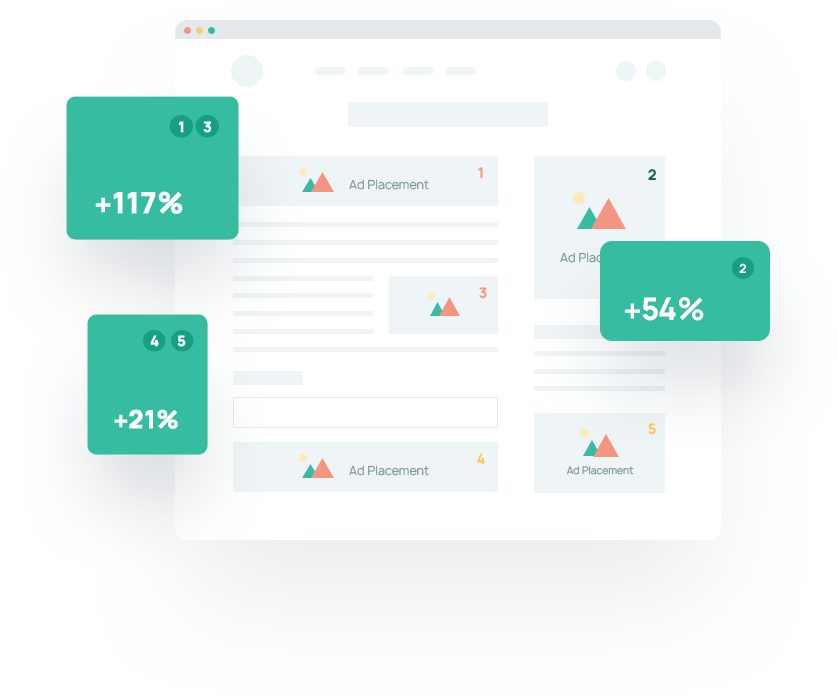
If a term includes the word penalty, there’s no way it could be anything but bad news. And that’s what Google Algorithm penalties are: bad news. If your website doesn’t meet Google’s standards, they can flag your website and demote your ranking in their search engine results. That’s right; they don’t fine you, block you, or suspend you—they give you the computer software version of a cold shoulder.
And over what, a blog that they think is a spam post? Did you accidentally place text over text? Or maybe it’s one of the ten ads you have on your website. Ads are some of the most common reasons why the Google Algorithm will target your site. If Google thinks that your website is too top-heavy, it will discourage visitors from staying on your website—they will flag you.
Because ads are one of the most efficient ways for web publishers to monetize their site, it’s easy to get a little ad happy. Google has to reign you in.
It may not seem like a major deal since there are no fees involved, but an Algorithm penalty can really mess up the amount of traffic and visibility your website has. The process for reversing the penalty is a real pain, too. So you should stick to a handful of ad techniques that will help you avoid Google Algorithm penalties in the first place.
How the Penalty Works
After flagging your account, Google will send you a manual action report. You’ll find this report in the Google Search Console. The Google Search Console is what generates reports for users who want insight into traffic and performance on their website. The manual action report will remain in place until you resolve whatever issue the algorithm picked up.
Once you solve whatever issues you have, you need to then submit a Reconsideration Request. This request outlines the reason why the problem existed in the first place and how you fixed it. Let’s dive deeper into how we can fix our Algorithm errors.
Ads and Google Penalties
Google’s Page Layout algorithm is what flags you down here. As mentioned before, having too many ads on your website can earn you a penalty. That’s because ads slow down your website and ultimately affect user experience. Poor page loading speed is something publishers absolutely have to concern themselves with; Google’s Core Web Vitals will not forgive it. What you can do to avoid ad-related Google penalties is create user-friendly ads that are compatible with Google. This way, you not only optimize your ad placement strategy, but you also aren’t throwing up any old ad on your website.
Play it Safe
If you’re redesigning your ad space or having trouble with penalties consider starting with native formats first. Native advertising is advertising that matches the aesthetic of the website it’s in. When a user scrolls through a page, the idea is that the ad doesn’t distract them from their user experience but rather gently tell them that there’s a product or service they may be interested in. A banner is simply an ad orientation that runs horizontally across a page.
Balance Your Ads
If you are penalized for ads but don’t overuse them, check to make sure your ads are distributed well. Too many ads could be making your site top-heavy.
What qualifies as a top-heavy website is one that includes too many ads above the fold. The fold is the bottom of the landing page for whatever website you’re on. Once you start scrolling, you are beyond the fold. The fold varies depending on what device and screen resolution you have. The fold will appear much sooner in smaller technology, like a mobile device, as opposed to a large iMac screen that presents more information in one view.
Google does give sample layouts for ads above the fold that don’t push content below the fold. Ideally, you’ll place ads next to text, between the main body text and the sidebar, or you’ll place it below any introductory text on the landing page.
Protect Your Ad Space
As we’ll find out later on in the article, Google will issue you a penalty if your website is hacked. Ad fraud isn’t always in the form of a hack on a web publisher’s site—and it’s mostly targeted towards advertisers—but they can sneak in and take over your website to place text overlays, sneaky redirections, and hidden text on your page. Google will notice this and flag your website, even though it’s technically not your fault. Do yourself a favor; invest in decent website security.
Ad Content
Another way your ads could get you into trouble is if you violate any of Google’s policies on ad content. Depending on your ad exchange technology, you may or may not have too much control over what your website displays as an ad, but this is something to work out with your ad exchange team or the third-party service you’re using.
Google will issue you a penalty for ad content depicting the following:
- Counterfeit goods
- Dangerous products
- Inappropriate content
- Dishonest behavior
No explicit websites, no weapons or drugs, no fake IDs or documents, and definitely no graphic images of crime scenes or other tragic images.
Other Penalties
According to Google, there are five additional reasons why they issue Algorithm penalties.
- Unnatural Links
- Hacked Website/User-Generated Spam
- Thin Content
- Clocking/Redirects
- Keyword Stuffing/Hidden Text
Unnatural Links
Before Google updated its Algorithm with Penguin in 2012, anybody could add spam links to their own or an outside website. Web publishers were especially guilty of selling links to their websites, too. These links would quickly get them to rank on a Google search and the practice took off from there. Fortunately, Google put the kibosh on this rather annoying practice.
So if you’re thinking of buying links, forget about it. It’s probably a scam anyway. And if you already did it, you’ll have to go in and remove all of them:
- To do this properly, you’ll need to download the links to Google Search Console.
- Figure out which links violate Google’s policies.
- At the end of the hyperlink of the links in violation, add or remove rel=” nofollow”.
- If you cannot remove these links yourself, you’ll need to Disavow them. This is a whole other reporting process that requires you to upload a list of links to Google.
- Your Disavowed links should disappear within a few weeks.
Links are particularly helpful in website ads as they are great to stick a call to action on. But it’s a matter of building the links properly.
Hacked Website/User-Generated Spam
There’s so much spam across the Internet that it’s like a poor recreation of a Monty Python skit. And, just like the canned meat, it’s a niche market. Though regular visitors to a website can brush spam to the side, it’s a webmaster’s thorn in the side and something Google absolutely hates.
If you get a penalty for spam, immediately look towards any open comment sections. Spam classifies as anything that:
- Has a suspicious user name
- Has nothing to do with the topic
- Disguises as a comment but is actually an advertisement
- Includes off-topic links
You’ll then have to delete all these comments, fix your moderation settings, and submit the Reconsideration Request.
A hacked website is paired with spam because it is also something that is technically your fault. But it is your oversight. If you have a hacked website that’s blinking with nonsense spam, you have to clean it up and kick that hacker out of your site. Not only will you receive the usual penalty from Google, but you’ll also get hit with the “hacked website” label. That’s the equivalent to dead air on the radio—wasted space, losing money.
Increase your security on any ad exchanges you conduct for your site and don’t accidentally turn on yourself by posting harmful conversation starters in the comments section.
Thin Content
The thin content penalty will make you consider your content that much more. Google will call out a website if the posts are shallow and low-quality, add nothing to an affiliate ad, or are spun or doorway pages. Doorway pages are web pages, usually duplicates, that are made specifically to rank high.
Spun content is like cheating. It’s when you take an already written article and put it through a “spinner.” The spinner creates a brand new article out of the content you copied. It’s not good practice and Google will always catch you. The key to getting out of this one is cleaning out the system. Delete duplicate pages, affiliate content that adds no value, spun content, and doorway pages.
Scraped Content
Also known as plagiarism, scraped content is not original. Heck, you didn’t even bother to cover up the fact that you copied and pasted content from another site. Get rid of scraped content to resolve the penalty.
Cloaking/Redirects
Reserved for the truly sneaky, cloaking and redirects “lie” to the visitor. Cloaking shows visitors content that is not actually there—at least, according to Google. Redirects send the visitor to a website they didn’t click on, like being Rick-Rolled but with higher stakes. Not only do you get the Algorithm penalty for this, but you also end up violating Google’s webmaster policies.
Resolving this issue is time-consuming but necessary if you want to get rid of the penalty.
- Find out what content is appearing on Google searches by going to Google Search Console>Crawl>Fetch as Google.
- Compare the website pages you have to what is appearing on Google. You’ll need to resolve any discrepancies between the two sites—if they exist.
- Remove sneaky, shady redirects. Don’t redirect, be transparent.
Keyword Stuffing/Hidden Text
Yet another act of deception and overloading, keyword stuffing and hidden text take best SEO practices and make them a nuisance. In keyword stuffing, you “stuff” as many keywords into your content as possible. With hidden text, you type a keyword but set the font at zero. The website will still register the content, but visitors won’t be able to see it. Google will, though.
One of Google’s updates to the algorithm was BERT (Bidirectional Encoder Representations from Transformers). BERT helps Google detect unnaturally written content and is really good at catching keyword stuffing. Keyword stuffing is an innocent mistake to make as you learn SEO, but a good rule is to keep 2%-3% of your text dedicated to keywords.
We hope you’re a good editor because that’s what fixing this problem takes. Rewrite overstuffed content (you’re not an Oreo) and get rid of that hidden text.
Conclusion
It’s not that hard to avoid Google Algorithm penalities. Even when Google updated the penalty to include the Page Layout algorithm, not too many websites were affected. The ones that were updated their pages to improve user experience—nothing wrong with that!
And that’s what these penalties do. They make sure that the visitor gets the best possible user experience, and They keep web publishers in check. We can’t fault Google for that.
Still, when you’re hit with a demotion in your SEO ranking, it hurts and the hurt runs deeper than you think. It stings worse when the very thing it flagged is the main source of your website’s revenue. Skip the bother and create carefully placed advertisements that comply with Google’s standards. As long as Google approves, you’re in the clear.
